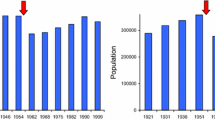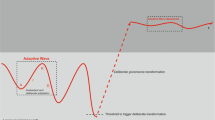Abstract
Natural floodplains are complex social-ecological systems in which human livelihoods are tightly coupled with flooding dynamics. In this paper, we argue that hydraulic planning in such systems, including to mitigate extreme floods, must consider three key features of adaptive self-organizing systems in floodplains - connectivity, learning feedbacks, and rhythms - to support the resilience of floodplain communities to extreme floods. We illustrate this argument with a case study of the Logone Floodplain, Cameroon. Based on hydrological data, ethnographic research and a series of focus group interviews with floodplain villagers, we analyze the interplay of top-down planning and adaptive self-organization in response to two extreme floods in 2012 and 2015. We show that recent top-down strategies of hydraulic control in the floodplain have led to more hydraulic uncertainty for local populations, and curtailed the conditions for sustainable self-organization in the floodplain.




Similar content being viewed by others
References
Adams, W. M. A. (2014). Wasting the rain (Routledge revivals): Rivers, Routledge, People and Planning in Africa.
Arthington, A. H., and Balcombe, S. R. (2011). Extreme flow variability and the ‘boom and bust’ ecology of fish in arid zone floodplain rivers: A case history with implications for environmental flows, conservation and management. Ecohydrology 4(5): 708–720.
Biya, P. (2012). Allocution du chef de l’Etat a l’occasion de sa visite aux populations victimes des inondations dans les régions du Nord et de l’Extrême Nord. https://www.prc.cm/fr/multimedia/documents/524-allocution-du-chef-de-l-etat-guirvidig-20-09-2012 (accessed 1 March 2017)
Bonabeau, E., Theraulaz, G., Deneubourg, J. L., Aron, S., and Camazine, S. (1997). Self-Organization in Social Insects. Trends in Ecology & Evolution 12(5): 188–193.
CBLT. (2012). Rapport de l'atelier de validation du projet de rapport final de l'étude de faisablité du projet de transfert d'eau de l'Oubangui au lac Tchad. Niamey, 6-8 February. CBLT.
de Noray, M.-L. (2002) Waza Logone: histoires d'eaux et d'hommes; vivre dans la plaine inondable de Waza Logone au Cameroun. IUCN.
Delclaux, F., Seignobos, C., Liénou, G., and P. Genthon. (2010) Water and people in the Yaere floodplain (North Cameroon). Floodplains: Physical Geography, Ecology and Societal Interactions. Nova publishers, Hauppauge, New York.
Di Baldassarre, G., Brandimarte, L., and Beven, K. (2016). The seventh facet of uncertainty: Wrong assumptions, unknowns and surprises in the dynamics of human–water systems. Hydrological Sciences Journal 61(9): 1748–1758.
Di Baldassarre, G., Kooy, M., Kemerink, J. S., and Brandimarte, L. (2013). Towards understanding the dynamic behaviour of floodplains as human-water systems. Hydrology and Earth System Sciences 17(8): 3235.
Di Baldassarre, G., Montanari, A., Lins, H., Koutsoyiannis, D., Brandimarte, L., and Blöschl, G. (2010). Flood fatalities in Africa: From diagnosis to mitigation. Geophysical Research Letters 37(22).
Dumas, D., Mietton, M., Hamerlynck, O., Pesneaud, F., Kane, A., Coly, A., Duvail, S., and Baba, M. L. O. (2010). Large dams and uncertainties: The case of the Senegal River (West Africa). Society and Natural Resources 23(11): 1108–1122.
Fernández, A., Mohammad R. N., Durand, M., Bryan G. M., Moritz, M., Jung, H. C., Neal, J., Shastry, A., Laborde, S., Phang, S. C., Hamilton, I. M., Xiao, N. (2016). Testing the skill of numerical hydraulic modeling to simulate spatiotemporal flooding patterns in the Logone floodplain, Cameroon. Journal of Hydrology 539:265-280
Hamerlynck, O., Duvail, S., Vandepitte, L., Kindinda, K., Nyingi, D. W., Paul, J. L., Yanda, P. Z., Mwakalinga, A. B., Mgaya, Y .D., and Snoeks, J. (2011). To connect or not to connect? Floods, fisheries and livelihoods in the lower Rufiji Floodplain Lakes, Tanzania. Hydrological Sciences Journal 56(8): 1436–1451.
Hemelrijk, C. K., and Hildenbrandt, H. (2012). Schools of fish and flocks of birds: Their shape and internal structure by self-organization. Interface Focus 20120025.
Jones, P., and Macdonald, N. (2007). Making space for unruly water: Sustainable drainage systems and the disciplining of surface runoff. Geoforum 38(3): 534–544.
Jung, H. C., Alsdorf, D., Moritz, M., Lee, H., and Vassolo, S. (2011). Analysis of the relationship between flooding area and water height in the Logone floodplain. Physics and Chemistry of the Earth, Parts A/B/C 36(7): 232–240.
Krause, F. (2016). “One Man’s flood defense is another Man’s flood”: Relating through water flows in Gloucestershire, England. Society & Natural Resources 29(6): 681–695.
Krause, F. (2017). Towards an amphibious anthropology of Delta life. Human Ecology 45(3): 403–408.
Krause, F., and Strang, V. (2016). Thinking relationships through water. Society & Natural Resources 29(6): 633–638.
Laborde, S., Fernández, A., Phang, S. C., Hamilton, I. M., Henry, N., Jung, H. C., Mahamat, A., Ahmadou, M., Labara, B. K., Kari, S., and Durand, M. (2016). Social-ecological feedbacks lead to unsustainable lock-in in an inland fishery. Global Environmental Change 41: 13–25.
Lansing, J. S. (2012). Perfect order: Recognizing complexity in Bali. Princeton University Press.
Lansing, J. S., Thurner, S., Chung, N. N., Coudurier-Curveur, A., Karakaş, Ç., Fesenmyer, K. A., and Chew, L. Y. (2017). Adaptive self-Organization of Bali’s ancient Rice terraces. Proceedings of the National Academy of Sciences 201605369.
Lavigne Delville, P., and Hochet, P. (2005). Construire Une Gestion Négociée et Durable Des Ressources Naturelles Renouvelables en Afrique de l’ouest, Rapport Final de la Recherche [French], GRET/CLAIMS/AFD, Paris, p. 183.
Leauthaud, C., Duvail, S., Hamerlynck, O., Paul, J. L., Cochet, H., Nyunja, J., Albergel, J., and Grünberger, O. (2013). Floods and livelihoods: The impact of changing water resources on wetland agro-ecological production Systems in the Tana River Delta, Kenya. Global Environmental Change 23(1): 252–263.
Linton, J., and Budds, J. (2014). The Hydrosocial cycle: Defining and mobilizing a relational-dialectical approach to water. Geoforum 57: 170–180.
Magrin, G., Lemoalle, J. et Raimond, C. (2014). « Les futurs du lac Tchad : réflexions prospectives, en guise de conclusion. » In Lemoalle J. et Magrin G. (eds.) Le développement du lac Tchad : situation actuelle et futurs possibles. Expertise Collégiale.
Magrin, G. (2016). The disappearance of Lake Chad: History of a myth. Journal of Political Ecology 23: 204–222.
Mahamat, A., and Diaouré, A. A. (2008). Pratique des canaux de pêche dans la plaine d’inondation du fleuve Logone: un coup fatal aux écosystèmes des zones humides sahéliennes, ACEEN, Maroua, Cameroon.
Moritz, M., Hamilton, I. M., Chen, Y.-J., and Scholte, P. (2014). Mobile pastoralists in the Logone floodplain distribute themselves in an ideal free distribution. Current Anthropology 55(1): 115–122.
Moritz, M., Laborde, S., Phang, S. C., Ahmadou, M., Durand, M., Fernandez, A., Hamilton, I. M., Kari, S., Mark, B., Scholte, P., and Xiao, N. (2016). Studying the Logone floodplain, Cameroon, as a coupled human and natural system §. African Journal of Aquatic Science 41(1): 99–108.
Moritz, M., Scholte, P., Hamilton, I. M., and Kari, S. (2013). Open access, open systems: Pastoral Management of Common-Pool Resources in the Chad Basin. Human Ecology 41(3): 351–365.
Moussaïd, M., Perozo, N., Garnier, S., Helbing, D., and Theraulaz, G. (2010). The walking behaviour of pedestrian social groups and its impact on crowd dynamics. PLoS One 5(4): e10047.
Nikula, J. (2008). Is harm and destruction all that floods bring. Modern myths of the Mekong-a critical review of water and development concepts, principles and policies: Water & Development Publications-Helsinki University of Technology. Finland, pp. 27-38.
Ostrom, E. (2008). Polycentric systems as one approach for solving collective-action problems. Indiana University, Bloomington: School of Public & environmental affairs research paper, (2008-11), p. 02.
Pickering, A. (2006). New ontologies. Andrew Pickering. https://ore.exeter.ac.uk/repository/bitstream/handle/10036/29882/newontols1006.pdf?sequence=3 (accessed 1 Feb 2017)
Raimond, C., Rangé, C. et Guérin, H. (2014). « La multi-activité et la multifonctionnalité, principes d'un développement durable pour le lac Tchad ? » In Lemoalle J. et Magrin G. (eds.) Le développement du lac Tchad : situation actuelle et futurs possibles. Expertise Collégiale. IRD, Marseille p.423-474.
Rangé, C. (2016). Multi-usage des ressources et mobilités: l’intensification dans une zone humide sahélienne- Le lac Tchad vu par sa fenêtre camerounaise. PhD thesis. AgroParisTech, Laboratoire Prodig (UMR 8586). Anthropologie & Développement 44: 199–200.
République du Cameroun. (2014a). Études techniques en vue de la construction d’une digue-route, la protection des berges et l’aménagement des infrastructures hydro-agricoles le long du fleuve Logone entre Gobo et Kousseri, dans la région de l’Extrême-Nord – Termes de Reference.
République du Cameroun. (2014b). Études d’impact environnemental et social du projet d’urgence pour la lutte contre les inondations (PULCI) dans la region de l’extreme-nord du Cameroon.
Scholte, P. (2005). Floodplain rehabilitation and the future of conservation & development. Adaptive management of success in Waza-Logone, Cameroon. Wageningen Research Centre, Wageningen University.
Scott, J. C. (1998). Seeing like a state: How certain schemes to improve the human condition have failed, Yale University Press, New Haven.
Seignobos, C., and Iyébi-Mandjek, O. (eds.) (2000). Atlas de la Province Extrême-Nord Cameroun, IRD & MINREST, Paris.
Swyngedouw, E. (2009). The political economy and political ecology of the hydro-social cycle. Journal of Contemporary Water Research & Education 142(1): 56–60.
Varela, F. J. (1999). Ethical know-how: Action, wisdom, and cognition. Stanford University Press.
Acknowledgements
The research for this article was financially supported by the National Science Foundation, Dynamics of Coupled Natural and Human Systems Program (BCS- 1211986). We want to thank Aboukar Edouard, Moumoum Mahamat, Moussa Barka and Adam Afding for assisting with the focus groups interviews, and people from the villages of Lahaï, Padmangaï, Araïnaba, Gala, Sara-Sara and Malazina who took part in the research. We also thank Alejandro Camargo and Luisa Cortesi for review of a previous draft, and organizers of the International Conference on Chadian Lake Ecosystems (GELT, N’Djamena, April 2017) for engaging discussions around the topic of the paper. We thank the Chadian Ministry for Environment and Water for Logone River discharge data, and two reviewers for their helpful feedback.
Author information
Authors and Affiliations
Corresponding author
Rights and permissions
About this article
Cite this article
Laborde, S., Mahamat, A. & Moritz, M. The interplay of top-down planning and adaptive self-organization in an African floodplain. Hum Ecol 46, 171–182 (2018). https://doi.org/10.1007/s10745-018-9977-y
Published:
Issue Date:
DOI: https://doi.org/10.1007/s10745-018-9977-y




